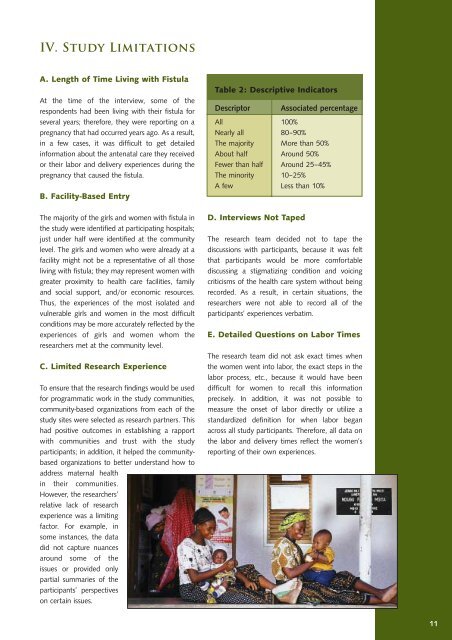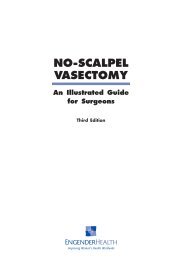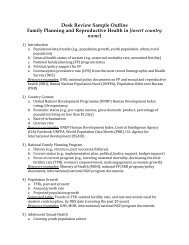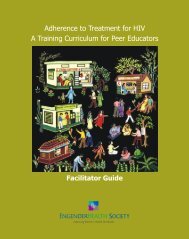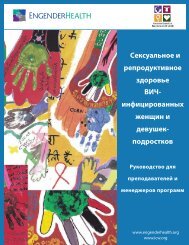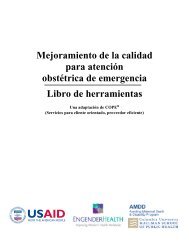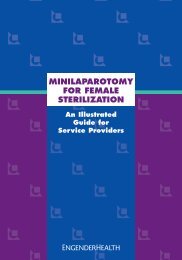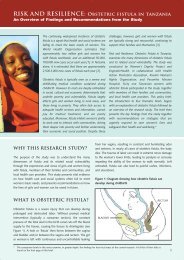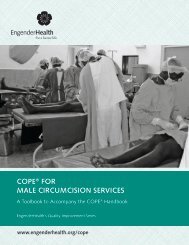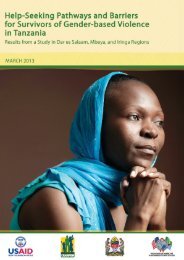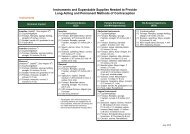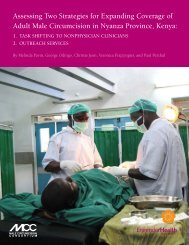Risk and Resilience: Obstetric Fistula in Tanzania - EngenderHealth
Risk and Resilience: Obstetric Fistula in Tanzania - EngenderHealth
Risk and Resilience: Obstetric Fistula in Tanzania - EngenderHealth
Create successful ePaper yourself
Turn your PDF publications into a flip-book with our unique Google optimized e-Paper software.
IV. Study Limitations<br />
A. Length of Time Liv<strong>in</strong>g with <strong>Fistula</strong><br />
At the time of the <strong>in</strong>terview, some of the<br />
respondents had been liv<strong>in</strong>g with their fistula for<br />
several years; therefore, they were report<strong>in</strong>g on a<br />
pregnancy that had occurred years ago. As a result,<br />
<strong>in</strong> a few cases, it was difficult to get detailed<br />
<strong>in</strong>formation about the antenatal care they received<br />
or their labor <strong>and</strong> delivery experiences dur<strong>in</strong>g the<br />
pregnancy that caused the fistula.<br />
B. Facility-Based Entry<br />
The majority of the girls <strong>and</strong> women with fistula <strong>in</strong><br />
the study were identified at participat<strong>in</strong>g hospitals;<br />
just under half were identified at the community<br />
level. The girls <strong>and</strong> women who were already at a<br />
facility might not be a representative of all those<br />
liv<strong>in</strong>g with fistula; they may represent women with<br />
greater proximity to health care facilities, family<br />
<strong>and</strong> social support, <strong>and</strong>/or economic resources.<br />
Thus, the experiences of the most isolated <strong>and</strong><br />
vulnerable girls <strong>and</strong> women <strong>in</strong> the most difficult<br />
conditions may be more accurately reflected by the<br />
experiences of girls <strong>and</strong> women whom the<br />
researchers met at the community level.<br />
C. Limited Research Experience<br />
To ensure that the research f<strong>in</strong>d<strong>in</strong>gs would be used<br />
for programmatic work <strong>in</strong> the study communities,<br />
community-based organizations from each of the<br />
study sites were selected as research partners. This<br />
had positive outcomes <strong>in</strong> establish<strong>in</strong>g a rapport<br />
with communities <strong>and</strong> trust with the study<br />
participants; <strong>in</strong> addition, it helped the communitybased<br />
organizations to better underst<strong>and</strong> how to<br />
address maternal health<br />
<strong>in</strong> their communities.<br />
However, the researchers’<br />
relative lack of research<br />
experience was a limit<strong>in</strong>g<br />
factor. For example, <strong>in</strong><br />
some <strong>in</strong>stances, the data<br />
did not capture nuances<br />
around some of the<br />
issues or provided only<br />
partial summaries of the<br />
participants’ perspectives<br />
on certa<strong>in</strong> issues.<br />
Table 2: Descriptive Indicators<br />
Descriptor<br />
D. Interviews Not Taped<br />
Associated percentage<br />
All 100%<br />
Nearly all 80–90%<br />
The majority More than 50%<br />
About half Around 50%<br />
Fewer than half Around 25–45%<br />
The m<strong>in</strong>ority 10–25%<br />
A few Less than 10%<br />
The research team decided not to tape the<br />
discussions with participants, because it was felt<br />
that participants would be more comfortable<br />
discuss<strong>in</strong>g a stigmatiz<strong>in</strong>g condition <strong>and</strong> voic<strong>in</strong>g<br />
criticisms of the health care system without be<strong>in</strong>g<br />
recorded. As a result, <strong>in</strong> certa<strong>in</strong> situations, the<br />
researchers were not able to record all of the<br />
participants’ experiences verbatim.<br />
E. Detailed Questions on Labor Times<br />
The research team did not ask exact times when<br />
the women went <strong>in</strong>to labor, the exact steps <strong>in</strong> the<br />
labor process, etc., because it would have been<br />
difficult for women to recall this <strong>in</strong>formation<br />
precisely. In addition, it was not possible to<br />
measure the onset of labor directly or utilize a<br />
st<strong>and</strong>ardized def<strong>in</strong>ition for when labor began<br />
across all study participants. Therefore, all data on<br />
the labor <strong>and</strong> delivery times reflect the women’s<br />
report<strong>in</strong>g of their own experiences.<br />
11


